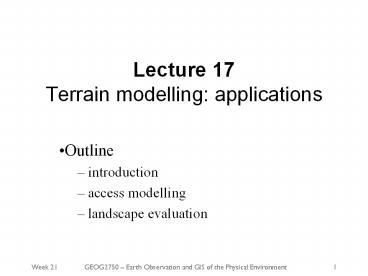Lecture 17 Terrain modelling: applications - PowerPoint PPT Presentation
1 / 31
Title:
Lecture 17 Terrain modelling: applications
Description:
Lecture 17 Terrain modelling: applications Outline introduction access modelling landscape evaluation Introduction Many applications of terrain models visualisation ... – PowerPoint PPT presentation
Number of Views:175
Avg rating:3.0/5.0
Title: Lecture 17 Terrain modelling: applications
1
Lecture 17Terrain modelling applications
- Outline
- introduction
- access modelling
- landscape evaluation
2
Introduction
- Many applications of terrain models
- visualisation covered already
- hillshading and orthographic views
- animation and photorealism
- others
- access modelling
- visibility analysis and landscape evaluation
- slope and hazard mapping
- hydrological modelling
3
Access modelling
- Terrain is a vital element for realistic access
models - flat, boundless plains of Weberian industrial
location analysis just dont exist! - need to take terrain-based costs into account
- Slope as push/pull factor
- Barrier features
- additional layer in GIS access models
4
Distance models
- Isotropic distance models
- dont take cost factors into account
- e.g. eucdistance in GRID or buffer in Arc/Info
- Anisotropic distance models
- take cost factors into account
- e.g. costdistance in GRID
5
Example distance model output
Buffer zones
Distance surface
Anisotropic surface
Residuals
6
Routing models
- Cost or friction surfaces can be used to
calculate shortest path between two points - Euclidean model takes only distance into account
- result is straight line or as the crow flies
- anisotropic model takes cost or friction surface
into account - may be positive (push) or negative (pull)
- uses cost of traversing a cell in a particular
direction to identify least accumulative cost
route - result is unlikely to be a straight line
7
Example routing output
Crianlarich-Benmore circular walk
Minimum distance/time surface
Check-points
Actual route
Predicted route
8
Case study modelling remoteness
- Off-road accessibility is function of
- distance from nearest road
- slope relative to direction of travel
- ground conditions (trafficability)
- barrier features (rivers, lakes, cliffs, etc.)
- Combine within anisotropic access model as cost
or friction surfaces
9
Question
- What other cost factors might we include in a
model of off-road accessibility?
10
Remoteness model
- Combined model integrating
- Dijkstras Shortest Path Algorithm
- calculate shortest path from origin to any
destination based on relative costs of movement
through set of cells between origin and
destination - Naismiths Rule (1892)
- an hour for every three miles on the map, with
an additional hour for every 2,000 feet of
ascent - -10 minutes/300 m descent for slopes 5gt12 10
minutes/300 m descent for slopes gt12
11
Results
- Naismith's/Dijkstra's model used to model
relative remoteness of Cairngorms area under
different scenarios - with and without mountain-bike access along
trails - before and after proposed ski funicular
- ArcGIS alternative Costpath
- calculates the least-accumulative-cost distance
over cost surface from source cell(s) accounting
for surface distance and horizontal/vertical cost
factors.
12
What if? modelling of Mountain bike
restrictions Mar Lodge estate
With mountain bike use along track from Linn of
Dee
Without mountain bike use along track from Linn
of Dee
13
Effects of the Cairngorm Ski Funicular
With parking restrictions at the Day Lodge and
along access road
Without parking restrictions at the Day Lodge or
along access road
14
Visibility analysis
- Use of DTM to calculate viewshed of particular
point - where can point X be seen from on surface Y?
- what part of surface Y can be seen from point X?
- Multiple point viewsheds combined to calculate
viewshed of line and area features - where and part of feature X be seen on surface Y?
- what part of surface Y can be seen from which
point on feature X?
15
Calculating viewsheds
- Uses line of sight from observer point to terrain
surface to calculate intervisibility matrix - visible parts of terrain surface
- non-visible areas (i.e. dead areas)
- Use of observation point and terrain offsets
- e.g. height of person or observation tower
- e.g. height of wind turbine or other feature
16
Calculating an inter-visibility matrix
Offset a
Offset b
v
v
v
nv
nv
nv
without offset b
with offset b
not visible
visible
17
Example viewsheds
18
Uses of visibility analysis
- Many different uses
- visual impact analysis
- landscape evaluation
- siting of observation towers and cellular
communications masts - modelling coverage of cellular communications
- military applications
- virtual GIS
19
Wind farm impact assessment
20
Landscape evaluation of Scotland
Intervisibility matrix (After Miller)
50m DEM
Littons 1968 scenic assessment
21
Landscape evaluation of Britain
22
Visual impact of human features
23
Cell phone coverage
24
Military applications
25
Virtual GIS
26
Conclusions
- Many uses for DEMs in environmental applications
of GIS - key variable determining accessibility
- important landscape variable
- controlling factor in gravity hazards including
flooding, avalanches, landslides, etc.
27
Practical
- Visibility assessment
- Task Calculate viewshed of a wind farm
- Data The following datasets are provided
- Digital elevation model (50m resolution 150,000
OS Panorama data) - Wind farm turbine location(s)
- ITE LCM90 data
28
Practical
- Steps
- Display DEM and turbine locations in ArcMap or
GRID - Calculate viewshed of wind turbines using both 1
and 16 turbines assuming a turbine height of 30m
using visibility - Display results in ArcMap or GRID
29
Learning outcomes
- Familiarity with the VISIBILITY command in
Arc/Info - Experience with developing impact assessments
based on environmental variables
30
Useful web links
- Access modelling
- http//www.geogr.ku.dk/dkgs/image/pub_pdf/artikler
/2002/GT2002_05tb.pdf - Archaeology and viewshed analysis
- http//www.casa.arizona.edu/MPP/viewshed/vspaper.h
tml - Scenic highway designation
- http//crssa.rutgers.edu/projects/highway/highway.
html
31
Next week
- Hydrological modelling
- Basics of hydrology
- Creating hydrologically correct DEMs
- Modelling catchment variables
- Practical
- Derive stream network from DEM































